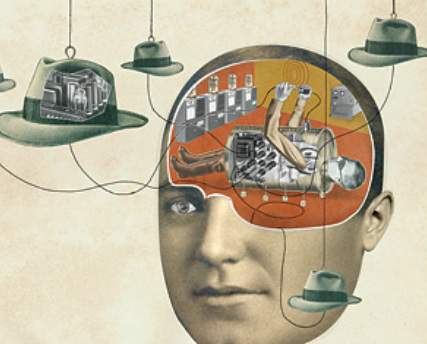
Neural changes happen when we shift our thought patterns. What’s amazing is that your brain actually creates new pathways for thinking, and the same old, same old ain’t the same no more. Start by learning to recognize what ways negative thinking keeps you repeating choices that don't serve you. Then ask yourself what thoughts would be more useful and try them on for size.
“Using the power of focused attention, along with the ability to apply commitment, hard work and dedication, to direct your choices and actions, you can thereby rewire your brain to work for you and with your true self. “
“Using the power of focused attention, along with the ability to apply commitment, hard work and dedication, to direct your choices and actions, you can thereby rewire your brain to work for you and with your true self. “
By Ann C.Holm, MS ACC CCC.
Re-posted from post on Thursday, March 21, 2013 by International Coach Federation
Your brain changes all of the time. What was once described merely as learning now has a neuro- label: neuroplasticity. Neuroplasticity is notion that mental experiences and mindfulness can change the actual structure and function of the brain. The idea of neuroplasticity is good news because it means we can change and grow up until our very last days of existence. It can also be bad news if we don’t attempt to direct our brain toward experiences that will change our brain for the better.
There are at least three ways that the neuroplasticity process occurs:
One way neuroplastic change can take place, is when some sort of dampening down of the usual mind map occurs. So for example, if you were going to learn a new language, you would do well to eliminate as much use of the native language as possible so the new language can build resilient neuro-connections in the brain. The brain doesn’t like competing stimuli. That is why language immersion programs seem to work. Basically you direct your efforts toward a new behavior while resisting the use of an old, competing behavior.
Another way is to bring about can bring about neuroplastic changes in the brain is a mindful, goal-directed approach. Either through self-driven intent or the external guidance, the brain can adapt to the demands placed upon it. The result is resilient change. An example of this would be setting goals around becoming a more effective networker. Ultimately networking begins to feel more natural because you have deliberately pushed yourself through the learning process via goal setting and the motivation to embrace the process of learning. Your brain changes as a result of this.
Finally, changes can take place in the brain as a result of passive learning experiences. This can either be positive or negative depending on what you are exposed to, but it is generally not goal directed or mindful. Human beings have a tendency to adapt to their current environment, whether positive or negative. It’s probably built into us for reasons of survival. Unfortunately, this tendency can also derail us from our goals unless we deliberately pay attention to our environment. Are we surrounding ourselves by stimuli that support our vision?
I recently came across the term Self-Directed Neruoplasticity (You Are Not Your Brain, Jeffrey Schwartz 2011). The author describes the term in this way:
“Using the power of focused attention, along with the ability to apply commitment, hard work and dedication, to direct your choices and actions, you can thereby rewire your brain to work for you and with your true self. “
Actively focusing attention on developing new healthy brain circuits is achieved by having a clear sense of goals and values. It is one of the best ways to get the most out of our capacity to adapt and change at the level of the brain via the wonderful gift of neuroplasticity.
Ann C.Holm, MS ACC CCC. Ann is an ICF certified coach with a lifelong interest in brain science. For 25 years, she coached brain injured clients toward cognitive recovery with an emphasis toward optimal functioning in the community.
Re-posted from post on Thursday, March 21, 2013 by International Coach Federation
Your brain changes all of the time. What was once described merely as learning now has a neuro- label: neuroplasticity. Neuroplasticity is notion that mental experiences and mindfulness can change the actual structure and function of the brain. The idea of neuroplasticity is good news because it means we can change and grow up until our very last days of existence. It can also be bad news if we don’t attempt to direct our brain toward experiences that will change our brain for the better.
There are at least three ways that the neuroplasticity process occurs:
One way neuroplastic change can take place, is when some sort of dampening down of the usual mind map occurs. So for example, if you were going to learn a new language, you would do well to eliminate as much use of the native language as possible so the new language can build resilient neuro-connections in the brain. The brain doesn’t like competing stimuli. That is why language immersion programs seem to work. Basically you direct your efforts toward a new behavior while resisting the use of an old, competing behavior.
Another way is to bring about can bring about neuroplastic changes in the brain is a mindful, goal-directed approach. Either through self-driven intent or the external guidance, the brain can adapt to the demands placed upon it. The result is resilient change. An example of this would be setting goals around becoming a more effective networker. Ultimately networking begins to feel more natural because you have deliberately pushed yourself through the learning process via goal setting and the motivation to embrace the process of learning. Your brain changes as a result of this.
Finally, changes can take place in the brain as a result of passive learning experiences. This can either be positive or negative depending on what you are exposed to, but it is generally not goal directed or mindful. Human beings have a tendency to adapt to their current environment, whether positive or negative. It’s probably built into us for reasons of survival. Unfortunately, this tendency can also derail us from our goals unless we deliberately pay attention to our environment. Are we surrounding ourselves by stimuli that support our vision?
I recently came across the term Self-Directed Neruoplasticity (You Are Not Your Brain, Jeffrey Schwartz 2011). The author describes the term in this way:
“Using the power of focused attention, along with the ability to apply commitment, hard work and dedication, to direct your choices and actions, you can thereby rewire your brain to work for you and with your true self. “
Actively focusing attention on developing new healthy brain circuits is achieved by having a clear sense of goals and values. It is one of the best ways to get the most out of our capacity to adapt and change at the level of the brain via the wonderful gift of neuroplasticity.
Ann C.Holm, MS ACC CCC. Ann is an ICF certified coach with a lifelong interest in brain science. For 25 years, she coached brain injured clients toward cognitive recovery with an emphasis toward optimal functioning in the community.

 RSS Feed
RSS Feed